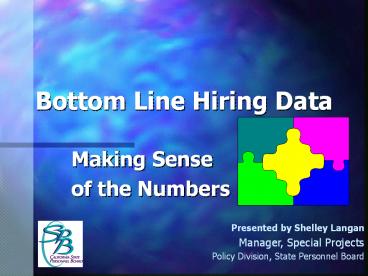Bottom Line Hiring Data - PowerPoint PPT Presentation
1 / 15
Title:
Bottom Line Hiring Data
Description:
Bottom Line Hiring Data Making Sense of the Numbers Presented by Shelley Langan Manager, Special Projects Policy Division, State Personnel Board What is Bottom Line ... – PowerPoint PPT presentation
Number of Views:45
Avg rating:3.0/5.0
Title: Bottom Line Hiring Data
1
Bottom Line Hiring Data
- Making Sense
- of the Numbers
Presented by Shelley Langan Manager, Special
Projects Policy Division, State Personnel Board
2
What is Bottom Line Hiring Data and Why is it
Needed?
- Bottom Line Hiring data indicates the results of
a selection process and the presence of adverse
impact - Each step of the selection process is evaluated
for the presence of adverse impact - The passing rate of each group of candidates is
calculated - Each groups passing rate is compared to the
passing rate of the highest passing group - 80 or 4/5ths rule
3
80 or 4/5ths Rule
4
History of Adverse Impact
- Griggs v. Duke Power (1971)
- Using the standard of the Civil Rights Act of
1964, the Court said - Nothing in the Act Title VII prevents employers
from requiring that applicants be fit for the
job. - Any selection procedure resulting in adverse
impact must be shown to be based upon business
necessity (that is, job-related) - Whether an employer intends to discriminate does
not matter
5
History of Adverse Impact
- Uniform Guidelines on Employee Selection
Procedures - Adopted in 1978
- Adopted by four federal agencies
- Equal Employment Opportunity Commission
- Civil Service Commission
- Department of Labor
- Department of Justice
- Provide a uniform federal position on illegal
discrimination in employment selection
6
History of Adverse Impact
- Connecticut v. Teal (1982)
- The employer must ensure that all components of a
multiple-step selection process have no adverse
impact. - Evidence of adverse impact at any step of the
selection process constitutes adverse impact - Employers can not hide adverse impact in a
process by demonstrating none at the bottom line
7
Adverse Impact
- So...
- Evidence of adverse impact must be considered
- Bottom line hiring data is the evidence
- Adverse impact is only defensible on the basis of
job-relatedness (i.e., business necessity)
8
Bottom Line Hiring Data
- Bottom Line Hiring Report
- Evidence of adverse impact is looked for at each
step of the selection process - Application screening
- Written exam
- Interview
- Performance test
- List eligibility
- Appointment
9
Bottom Line Hiring Data
- Bottom Line Hiring Report
- Types of reports
- 631 - by ethnicity and gender
- 632 - by age group and gender
- 633 - by disability and gender
- 634 - by disability and gender (combined
disability s, too) - 636 - by ethnicity and gender (others and DNSs
combined) - How to interpret reports
- 80 rule (4/5ths rule)
10
Interpreting the Bottom Line Hiring Report
11
Interpreting the Bottom Line Hiring Report
12
Interpreting the Bottom Line Hiring Report
- Is there evidence of adverse impact at any step
in the selection process? - At what point in the process is the adverse
impact occurring? - Can the adverse impact be justified on the basis
of job-relatedness?
13
Interpreting the Bottom Line Hiring Report
Interpreting the Bottom Line Hiring Report(cont.)
- Are there alternate selection procedures that
could be used to assess candidate qualifications
that would not result in adverse impact or would
provide for lesser adverse impact? - Use a performance test rather than an interview
- Use a written exam rather than an essay test
14
Interpreting the Bottom Line Hiring Report(cont.)
- Is there a consistent pattern of adverse impact
for certain classifications or for certain types
of selection procedures used for these
classifications? - Can the reason for the adverse impact be
identified? - Is there adverse impact for one classification
that could be impacting hiring results for the
whole occupational group?
15
What Next?
- Ensure that selection processes and their
individual selection procedures are job-related
(whether or not evident of adverse impact exists) - Ensure that selection procedures are soundly
developed to accurately and appropriately assess
candidate qualifications - Ensure that exam staff are adequately trained
- Ensure that hiring supervisors are trained to
make sound, job-related hiring decisions
16
The challenge in interpreting bottom line hiring
data...































